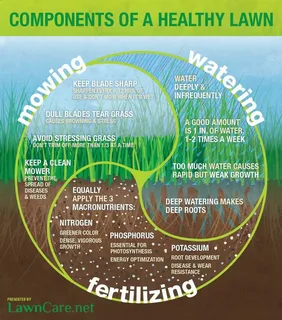Apply compost and mulch as a foundation for your green space. These materials enhance soil structure and provide essential nutrients, promoting a thriving ecosystem beneath the surface. Aim for a depth of 2-3 inches when applying mulch and integrate compost into the topsoil to improve moisture retention and microbial activity.
Utilize a variety of native plants and grasses that are well-suited to your local climate. This reduces the need for additional water and pesticides, creating a more resilient environment. Conduct soil testing to identify specific nutrient needs and pH levels, allowing for tailored amendments based on the results.
Incorporate natural pest control methods. Introduce beneficial insects, such as ladybugs and lacewings, to help manage pests naturally. Companion planting also plays a crucial role, as certain plants can deter unwanted insects while encouraging healthy growth among neighboring plants.
Regular mowing contributes to overall vigor. Maintain the blade height at around 3 inches to encourage deeper root growth and shade out weeds. Avoid cutting more than one-third of the grass height at once, which can stress the plants and lead to a decline in health.
Watering practices should focus on deep, infrequent irrigation. This encourages root systems to grow deeper into the soil, making them more resilient during dry spells. Implement a schedule based on rainfall and soil moisture levels to optimize water usage.
Choosing the Right Organic Fertilizers for Your Lawn
Select slow-release products that supply nutrients gradually over time. Look for those containing ingredients like composted manure, bone meal, or fish emulsion to boost soil vitality. Products based on seaweed can also promote root development and overall plant health.
Assess Soil Needs
Before selecting a fertilizer, conduct a soil test to determine nutrient levels and pH. This information helps you choose the most suitable formulation. A balanced ratio of nitrogen, phosphorus, and potassium is key, especially tailored to your specific grass type.
Application Timing
Opt for spring or fall applications to align with grass growth cycles. Avoid fertilizing during drought conditions or extreme heat, as this can stress the turf and hinder absorption. Water thoroughly after application to help the product penetrate the soil.
For more insights and resources, visit Garden Machinery Hub.
Natural Pest Control Solutions for a Thriving Yard
Introduce beneficial insects to manage harmful populations. Ladybugs and lacewings feed on aphids, while predatory nematodes target soil-dwelling pests. Create habitats by planting diverse flowering plants that attract these allies.
Homemade Sprays
Garlic and hot pepper spray can deter various insects. Blend a few cloves of garlic and a teaspoon of cayenne pepper with water, strain, and spray on affected areas. The strong scent repels pests, while being harmless to beneficial insects.
Companion Planting
Plant marigolds alongside vegetables to repel nematodes and other insects. Basil can deter flies and mosquitoes, while nasturtiums attract aphids away from other plants. Strategically pairing plants exploits natural relationships for better growth and protection.
Soil Health: Techniques for Enhancing Natural Nutrients
Utilizing cover crops is a highly efficient method to enrich your soil. These plants protect the earth from erosion and enhance nutrient availability. Consider sowing legumes, such as clover or vetch, which fix nitrogen in the soil.
Composting: A Nutrient-Rich Solution
Creating your own compost is a practical way to recycle organic matter and boost soil fertility. Combine kitchen scraps, yard waste, and other biodegradable materials. Maintain a balanced ratio of carbon-rich (brown) and nitrogen-rich (green) components to optimize decomposition.
Soil Aeration Techniques
- Implement manual core aeration in high-traffic areas to alleviate compaction. Removing small plugs of soil allows for better water and nutrient absorption.
- Spiking can also be beneficial. Use a garden fork to puncture the ground, ensuring improved root development and microbial activity.
Incorporating organic matter, such as well-rotted manure or leaf mold, helps to improve soil structure and enrich nutrient content. Regularly testing soil pH can guide you to adjust nutrient levels effectively. For precise solutions tailored to your region, visit Tommy for Wisconsin.
Utilize mulch around plants to retain moisture, suppress weeds, and gradually add nutrients as it breaks down. This not only supports plant growth but also enriches the microbial community in the soil.
Watering Practices That Support Organic Growth
Water deeply and infrequently. This method encourages roots to grow deeper into the soil, enhancing drought resistance. Aim for about 1 to 1.5 inches of water per week, either through rainfall or irrigation.
Timing is Key
Water early in the morning to minimize evaporation and fungal diseases. Avoid watering in the evening to reduce the risk of prolonged moisture on the surface, which can lead to issues.
Soil Moisture Monitoring
Utilize a moisture meter or simply dig a small hole to check soil dampness. Water only when the top inch of soil feels dry to the touch. This will prevent overwatering and promote an optimal growing environment.

